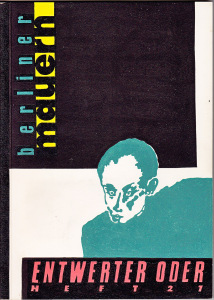Currently, the Saxon Library has a collection of almost 6000 artistic pieces and 177 artists’ books from the GDR. The collection is part of the wider graphics collection acquired by the library including almost 1300 artists’ books and graphic arts.
Among the first artists’ books acquired by the Library was also the publication USW, which captured the production of the alternative art scene in Dresden. This was offered to the library by publisher Micha Brendel in 1986. This was soon after followed by USF, issued by Thomas Haufe, also from Dresden, and by ENTWERTER/ODER from Berlin in 1987. The same year further publications were offered to the library such as DER HASE (from Chemnitz, then Karl-Marx Stadt), MIKADO and ANSCHLAG (Leipzig), SCHADEN (Berlin), and ZWEITE PERSON (Leipzig).
Among the artist contributing to these publications, one should note Cornelia Schleime and Sascha Anderson in Poe Sie All Bum (1982), Schulze Gundula (A drei, 1983), Via Lewandowsky (USW, 1987), Christoph Tannert (ANSCHLAG, 1986), Jan Faktor (Ariadnefabrik, 1986). Further international contributions came from Vaclav Havel (ANSCHLAG, 1987), Mircea Dinescu (ANSCHLAG, 1987), among others. The artists’ books experimented with various medium and techniques, from photography to drawing, silkscreen printing, collages, and text. The publications included topics such as poetry, literature, film, cinema, avant-garde art, sexuality, World War II, environmental issues, decay, the Czech movement Charta 77, bureaucracy, civil movements, among many others.
Following regime change, the Saxon library continued acquiring GDR publications. Some of the publications have been complemented or entire printings of some publications acquired, such as the collection UND of the artist Lothar Fiedler, expelled from the GDR in 1985.
For conservation reasons the collection has been digitalised and can be accessed online for research, while the originals can be studied in the reading room of the library.

